|
A CLOSE association existed between the Scotts and the family of James
Watt, the inventor of the steam engine: the founder of the Scotts'
shipbuilding firm and the father of Watt were identified I I !' r with
several schemes for the improvement of Greenock; and the signature. of
John Scott, of the third generation, whose portrait is the second
reproduced on Plate II., is taken from a document in connection with some
intromissions of town's funds, to which also is adhibited the signature of
Watt's father.
It is not surprising, therefore, that the Scotts were early close students
of Watt's inventive work, and among the first to enter upon the building
of steamships; while at the same time, as we have shown in the preceding
pages, building many of the fine sailing ships which established British
shipping supremacy in the early half of the nineteenth century, and raised
Greenock by 1829 to a port having trade with every part of the world.
Miller and Taylor commenced their experiments at Dalswinton in 1788, with
a steam engine driving paddlewheels in boats'. Symington's steam tug,
Charlotte Dundas, or by its success in 1802 on the Forth and Clyde Canal',
removed any remaining doubt; but it was not until 1812 that Henry Bell,
with his Comet, proved the commercial utility of the steam system,
although without. profit to the promoter! The building of steamships,
evolved by experiments by various workers in Britain - and in America
also—was readily adopted on the Clyde. Within four years of the completion
of the Comet, it was not unusual for five hundred or six hundred
passengers to enjoy in the course of one day water excursions on the
river. The fares were practically five times those prevailing to-day.
Among the earliest of the Clyde steamers were the Active, of 59 tons, and
Despatch, of 58 tons, built by the Scotts. In calculating the tonnage in
those early days, an average allowance of one-third was deducted for the
machinery. In 1816 the firm built the Shannon, of a length between
perpendiculars of 77 ft. 7 in., of a beam of 15 ft. 3 in., and of a depth
moulded of 9 ft. 1 in. She had fore-and- aft cabins. Her engines were of
14 horse-power nominal. She plied on the Shannon between Limerick and
Kilrush. By 1818—six years after the completion of the Comet— thirty-two
steamers were running on the Clyde, and some of these were sent ultimately
for traffic on the coast and on other rivers.' The largest of these was of
112 tons, with engines of 40 nominal horse-power.
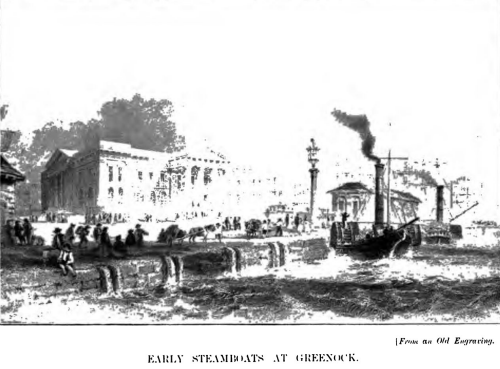
The Scotts had built many sailing craft for the Clyde and Belfast trade,
for the Glasgow and Liverpool service, and for the Liverpool and Drogheda,
and other coasting routes; and it was natural when steam was introduced
that the same firm should supply the side-paddle boats.
In three successive years -from 1819 to 1821 - the largest steamer in the
kingdom came from Scotts' Works. The record was marked in 1819 by the
Waterloo, of over 200 tons, with engines of 60 nominal horse-power; in
1820, by the Superb of 240 tons register, with engines of 72 nominal
horse-power, which cost about £37 per ton, and steamed 9 miles per hour,
using 1670 lb. of Scotch coal per hour; and in 1821, by the Majestic, of
345 tons register, with engines of 100 horse-power, which cost over £40
per ton, and steamed 10 miles per hour for a consumption of 2240 lb. of
Scotch coal. Although the modern steamer is fifty times the size of these
pioneers, with a cost per ton of less than one-fourth, and a fuel
consumption per unit of work done of not more than a seventh, the records
of these and other early ships are worthy of full reference.
The advantage of steam navigation for channel service was at once
recognised. A Parliamentary return issued in 1815 showed that for the
space of nine days in the previous year only one mail packet could sail
between Holyhead and Dublin owing to adverse winds, and even then the
average passage was twenty-four hours. Lord Kelvin, in his memorable
Address as Chancellor of the University of Glasgow, in 1905, recalled the
fact that early in the century his father often took three or four days to
cross from Belfast to Greenock in a smack, as she was frequently becalmed.
With favourable winds, rapid passages were made, a revenue cutter
occasionally doing the Belfast and Greenock run in ten hours.
The Greenock and Belfast route was among the first around the coast to
come under the influence of the mechanical system of propulsion. The Rob
Roy, which was the outcome, so far as form of hull was concerned, of
probably the first model experiments ever made—undertaken by David Napier
in the Canal at Camlachie—was in 1818 the pioneer in the Glasgow and
Belfast steam service, and later in the Dover and Calais steam service.
There followed in 1819 three notable vessels from Scotts' Works: the
Waterloo, the Robert Bruce, and the Sir William Wallace. The particulars
and performances of these vessels, taken from contemporary records,
principally the "Greenock Advertiser," which faithfully reported each
incident in the development of the steamship, are especially interesting
as illustrative of early work.
The Waterloo, which, as we have already said, was the largest steamer of
her year (1819), had a beam equal to one-fifth of her length, the
measurement between perpendiculars being 98 ft. 8 in. In addition to a
large number of passengers, she carried under ordinary conditions a cargo
of 100 tons, on a draught of 8 ft. 6 in. against 7 ft. 3 in. without
cargo. Three months were required, between the launch of the ship and her
trials, for the fitting on board of engines each of 30 nominal
horse-power, which gave her a speed of between 8 and 9 miles per hour.
Sails, however, were still carried to assist in driving the ship, and this
vessel was of schooner rig. She inaugurated the steam service between
Belfast and Liverpool.
The Robert Bruce was the first steamer to trade between the Clyde and
Liverpool! She was followed by the Sir William Wallace. Both were built by
the Scotts, and had engines of 60 nominal horse-power. They began service
in the summer of 1819; and the record of the maiden voyage of the former,
in August, 1819, showed that two and a-half hours were occupied in the run
from Glasgow to Greenock, about 22 miles; and within 26 hours thereafter
the vessel took on her pilot at the north-west lightship outside the
Mersey Bar. The return voyage was equally satisfactory. To quote again
from contemporary records, "the passengers, both out and home, were so
highly gratified with the performance of this vessel and their treatment
on board that they unanimously expressed their entire satisfaction with
Captain Paterson's exertions to render them comfortable and happy, their
conviction of the seaworthiness of the vessel, and their admiration of the
powers of the engines, capable of propelling so large a body at the rate
of 7 knots per hour, in the face of a strong north-northwest wind and high
sea for at least two-thirds of the way from Liverpool, her rate thither
being nearly 9 knots."
In 1820, the Superb, of 240 tons and 72 horse-power, followed the Sir
William Wallace, and marked a still further improvement. She had a copper
boiler, and in the three cabins sleeping accommodation was provided for
sixty- two passengers. She was "the finest, largest, and most powerful
steam vessel in Great Britain.2 The average duration of the passage from
the Clyde to Liverpool did not exceed 30 hours."
The Majestic, also for the Clyde and Liverpool service, was built in 1821,
and was 134 ft. 11 in. long between perpendiculars, 22 ft. 8 in. beam, and
14 ft. 5 in. depth, moulded. Her draught, 10 ft. 6 in. forward and 12 ft.
aft, was too great for the upper reaches of the Clyde, and passengers were
brought from Glasgow to Greenock in a tender. In her four cabins there was
greatly-increased accommodation for the passengers. She was probably the
first steamer with a sleeping apartment exclusively for ladies. The copper
boiler worked at a pressure of 4 lb. per square inch, and the engines ran
at 56 revolutions. The fares' to Liverpool in those days were £2 159., as
compared with us, to-day; of course, very much better accommodation is now
provided.
The City of Glasgow was built in 1822 for the Liverpool service. This
vessel, which cost £15,000, had a speed of over 10 knots, and was reputed
the fastest afloat. Her length was 110 ft. 4 in., beam 22 ft. 4 in., and
depth, moulded, 13 ft. She was arranged like the Majestic, and the two
were long the most important vessels in the Clyde and Liverpool trade. She
was subsequently bought by McIver, and inaugurated the competition with
the Burns line, commenced in 1829. The McIver and Burns lines were
subsequently combined.
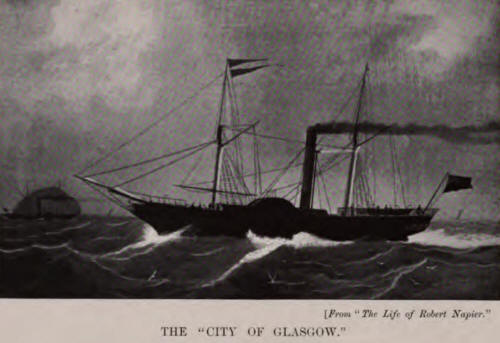
The Scotts rendered similar service in the development of the mail route
between Holyhead and Dublin. The first vessel built by them for this
service was the Ivanhoe, constructed in 1820. The steam service had been
opened between these two ports in 1819 by the Talbot, the first steamer
fitted with feathering floats. The Ivanhoe, a larger steamer than the
Talbot, was of 170 tons burden, her length between perpendiculars being 97
ft. 4 in., beam 19 ft., and depth, moulded, 14 ft. 6 in. She had various
improvements in her machinery, which was of 60 nominal horse-power. She
left Scotts' yard in May, 1820, and made the voyage to Howth (200 miles),
in 26½ hours.
Thus the Scotts continued to improve on each successive ship, and to widen
the area of their influence. The Clyde continued to largely monopolise the
industry of steam shipbuilding, and it was not until the summer of 1822
that a steamer—not built in Scotland—appeared on the Clyde. This was the
Saint George, from Liverpool, and the City of Glasgow, already referred
to, her competitor in the Liverpool trade, raced her and greatly excelled.
One of the first steamers to trade in the Mediterranean was the Superb,
sent thither in 1824, and the Trinacria, also built by the Scotts,
followed in 1825. These ran between Naples and Palermo. The last-named
vessel was 135 ft. long over-all, and 113 ft. 6 in. between
perpendiculars, 39 ft. 6 in. broad over the paddle-box, and 21 ft. 10 in.
net beam, 14 ft. deep (moulded), and of 300 tons burden. The vessel was
especially well-equipped, and cost £15,000. The engines, the first
manufactured by the Scotts at their Greenock foundry, were of 80 nominal
horse-power, and the boilers, which were of copper, weighed 40 tons. The
speed was 10 miles per hour. Later this steamer became the Hylton Jolffi,
and was employed by the General Steam Navigation Company on their London
and Hamburg service.
As to the yard in which these several vessels were built, suggestion is
afforded of the state of efficiency by the following quotation from a
history published in 1829. "The building yard of Messrs. Scott and Sons is
allowed to be the most complete in Britain, excepting those which belong
to the Crown. It has a fine extent of front from the West Quay to the
termination of the West Burn, and has a large dry dock, which was altered
lately to the plan of the new dock. All the stores and lofts are entirely
walled in, and, independently of the building premises, they have an
extensive manufactory of chain cables."
The majority of the engines for these early steamers of the Scotts were
constructed by Napier or Cook, and were of the side-lever or beam type. In
1825, however, John Scott, who had done so much for the progress of the
firm, decided to commence building machinery, and acquired for £5000 the
works which have since been developed into the well-known Greenock
Foundry. This establishment was begun, although on a very small scale,
about 1790, and in its equipment, which was considered thoroughly
efficient, there was included a laige cupola. Some idea is given of the
extent of the establishment by reference to Weir's "History of Greenock"
(1829), page 94, where it is stated that in the few years that had elapsed
since the taking over of the works by the Scotts "they have manufactured
some splendid engines, and—what is more to be looked for than the
appearance—they have wrought well. They have in hand the largest engine
ever made, which is of a size of 200 horse-power, and is intended for a
vessel building at Bristol. The number of men employed amount to about two
hundred and twenty, while the weekly distribution of wages is £180." As a
contrast, it may be said here that there are now four thousand men in the
works, earning per week over £5500 in wages, and that the Scotts are
engaged on the largest set of engines yet constructed by them—for H.M.S.
Defence. They are of 27,000 indicated horse-power, to give the immense
armoured cruiser named, of 14,600 tons displacement, a speed of 23 knots.
Since 1825, the Scotts have continued to do very satisfactory engine work,
much of it of an original character, not only for vessels built for
themselves, but for ships constructed on the Thames and other English
rivers, and also for the series of warships built for the British Navy at
their works, and for others constructed at the Royal Dockyards. This naval
engine work began with H.M. ships Hecla and Hecate, engined in 1838-9, and
the first warships built in the dockyards to be sent to Scottish works to
receive machinery. And here it may be noted, too, that
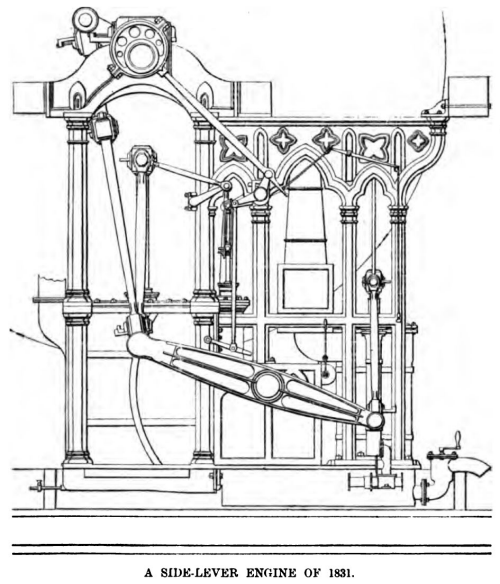
the first warship built by the Scotts was the Prince of Wales, in 1803,
and also that the firm had the credit of building the first steam frigate
constructed at Clyde works for the British Navy, H.M.S. Greenock, launched
in 1839. They also built the first compound engines fitted to a French
warship. With these naval ships and engines we deal in our next Chapter,
and may therefore continue our narrative regarding merchant steamers.
We reproduce on the preceding page a drawing illustrating an early type of
engine built by the firm. This is an engine constructed in 1831. The steam
cylinder is 521 in. in diameter, and the crank-shaft is actuated, through
connecting -rods, from the ends of the levers operated by the piston-rod,
while the air-pump is placed at the opposite ends of the levers.
A different type of engine, constructed in the following year (1832), is
illustrated on the facing page. In this case the cylinder operates the
opposite end of the levers to that connected with the crank-shaft. In both
engines the lever-gudgeon passes through the jet-condenser.
The records we have given are historically interesting, because they tell
of the beginnings of a great epoch in British shipping. We do not propose
to follow in such detail subsequent steamships, built for other services,
between London' and Aberdeen, the Clyde and Dublin, etc. The City of
Aberdeen, built in 1835 for the first- named, marked noteworthy progress.
She measured 187 ft. over the figure-head, and was of 1800 tons, including
the space for the machinery. Her poop was 60 ft. long and 45 ft. broad.
According to contemporary testimony, she was, in her day, the strongest
steamer built, having solid frames from gunwale to gunwale. She had
additional bracing with African oak stringers; oak and iron trussings
alternately bolted to the stringers formed a complete system of diagonal
fastenings and bindings from stem to stern. The whole of the cabins,
saloons and state rooms, were on one deck, and there was the important
innovation of hot and cold baths. The speed was 12 miles per hour.
The Jupiter, of 439 tons and 210 horse-power, built in 1836 for the Clyde
and Dublin trade, cost £20,000, and established a record in speed, making
the voyage in sixteen hours six minutes, at the rate of 13 miles per hour;
formerly the voyage took twenty-four hours.

In the late 'thirties and the early 'forties there was a great development
in oversea trading steamers, the Clyde• taking, then as now, the foremost
place. Several epoch- marking voyages had been made with the steam engine
used intermittently. The Savannah had thus crossed the Atlantic from the
United States in 1819, and the Royal William from Quebec in 1833.
The barque Falcon, 84 ft. in length, and of 175 tons, had, on the voyage
to India in 1835 utilised engines which, however, were removed on her
arrival in our Eastern dependency. Later in the same year the Enterprise,
of 470 tons and 120 horse-power, also rounded the Cape of Good Hope to
India. In all these cases, however, sails were utilised whenever possible,
and there was still great hesitancy in accepting the steam engine even as
an alternative on occasions to the use of the "unbought wind."- The
advantage, however, of a rate of speed which, while low, would be
constant, soon asserted itself, and there followed within a few years
regular mail steamship services on the North and South Atlantic Oceans, in
the Mediterranean Sea, in the Indian Ocean, and the China Seas. In the
beginning and development of these services the Scotts took a prominent
part.
One of the first notable steamship lines to be organised for oversea
service was that which ultimately became the Peninsular and Oriental
Company. It had its origin' in steamship service from Falmouth to Oporto,
Lisbon, Cadiz, and Gibraltar. Four steamers were built in 1836-37 the
Tagus, Don Juan, Braganza, and Iberia. The first- named was built by the
Scotts, and the third was engined by them. These ultimately carried the
mails as far as Alexandria, whence they were conveyed overland to Suez,
and from thence by the East India Company's vessels to Bombay. This
service developed into the Peninsular and Oriental service, when, in 1840,
the Company took over the mail service on the Indian Ocean; in 1847 they
extended their operations to China. The overland service continued until
the Suez Canal was opened in 1869, and many of the vessels for the
Mediterranean service, as well as for the eastern route, were built by the
Scotts.
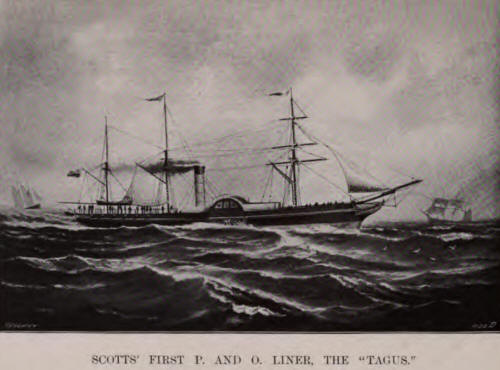
The Tagus,' which was thus amongst the first of the P. and 0. steamers,
was built in 1837. She had a length of 182.1 ft., a beam of 26 ft., and a
depth of 17 ft. 4 in., the burden tonnage being 709 tons. When carrying
265 tons of coal in her bunkers and 300 tons of cargo, the draught was 14
ft. 6 in. The side-lever engines which were fitted to her had a cylinder
62 in. in diameter, with a 5-ft. 9-in, stroke, developed 286 horse -
power, and operated paddle - wheels 23 ft. 6 in. in diameter. Two of the
other early steamers, the Jupiter and the Montrose, were also constructed
by the Scotts.
The conveyance of cargo and passengers across the Isthmus of Suez not only
involved inconvenience and expense, but was a cause of great delay. There
was still, however, a strong prejudice against steamships being utilised
for long sea voyages, partly because of vested interests in sailing ships.
Sir John Ross, C.B., who, in 1818 and in 1829 to 1833, made Arctic
explorations, was one of the strongest advocates for a service to India by
way of the Cape of Good Hope; and, in order to establish the feasibility
of the undertaking, made experiments with the City of Glasgow, built by
the Scotts in 1821. This vessel, of 283 tons, had in the interval been
fitted with new boilers, with special safety appliances, and they worked
at 4-lb. pressure; they gave the high evaporation in those days of 9 lb.
of water per pound of coal.
This vessel made the trip from London Bridge to the lightship off Spithead
(246 miles) in thirty-one hours five minutes, on a consumption of 6 lb. of
fuel per indicated horsepower per hour. These facts were utilised by Sir
John Ross in his advocacy of the route, and a new company was formed,
under his chairmanship, in 1837.
The first vessel of the fleet, named the India, was • built and engined by
the Scotts, and was a few years later transferred to the Peninsular and
Oriental Company. The India, launched in 1839, was the largest steamer
built on the Clyde up to that date, being 206 ft. 6 in. long, 30 ft. 9 in.
beam, or 48 ft. wide over the paddle-boxes. The gross tonnage was 1206
tons. Accommodation was provided for eighty cabin passengers, and
provision made for 400 tons of cargo. A feature of her construction was
the provision of two strong bulkheads of iron across the engine-room, in
order to avoid accidental outbreak of fire, and also to prevent water from
a leak in one part spreading to another.' This was probably the beginning
- nearly seventy years ago— of the system of division by watertight
bulkheads, now universal. Its compulsory adoption was advocated by the
Institution of Naval Architects in 1866, and enforced by Lloyds in 1882,
and by the Board of Trade in 1890. The machinery was of 320 horse - power,
and had surface- condensers. The India was launched on the anniversary of
the birth of James Watt, and a salute of twenty-one guns was fired as the
vessel left the ways.
Five other steamers were built for the service, and the voyage took from
fifty-five to sixty days, as compared with the one hundred and thirteen
days occupied by the Enterprise. A monthly service was thus rendered
possible. At the same time the Scotts built steam vessels for the coasting
trade of India and of South Africa.
The type of machinery in use at this period is illustrated on the opposite
page. This particular engine was constructed in 1838. The piston was
connected to one end of the side-levers, while the crank was operated from
the other. The paddle-wheel of this engine was 25 ft. 0½ in. in diameter,
with seventeen floats. For about thirty years this was the standard type
of marine engine for paddle steamers.
The Gothic architectural design for the main framing was gradually
abandoned for something less ornamental and perhaps more mechanical.
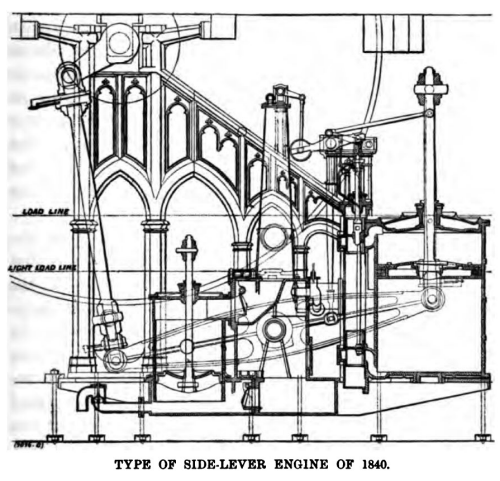
The Royal West India Mail Company's Service, still one of the best known
of British lines, was commenced in 1841. Some of the steamers were
purchased, but amongst those built originally for the service was the Dee
by the Scotts. She was 213 ft. 9 in. long, 30 ft. 4 in. beam, and 30 ft.
in depth, the burden tonnage being 1848 tons. On a draught of 17 ft. 6 in.
she carried 700 tons of cargo; and, as with most of the oversea liners of
the period, the average speed was only about 8 knots. The voyage of 13,650
miles occupied then one hundred and nine days, including stoppages; and
the consumption of fuel was 254 tons per day. The engines, which had
cylinders 73 in. in diameter with a stroke of 7 ft., were of 450 &iorsepower,
driving side paddle-wheels 28 ft. 6 in. in diameter.
In the thirty years from the first commercial British steamer, the Comet,
there had not been much advance in the steam engine, excepting in size,
power, and, perhaps, reliability. Wood had continued to be the
constructive material for all but the smallest ships. The size of vessels
had grown steadily to the 1848 tons of the West Indian mail liner, which
started regular steamship service almost contemporaneously with the
inauguration of the Atlantic mail line by the Cunard Company in 1840.
Speeds on service, even on the shortest routes, were seldom over 13 knots,
and on the long routes under 8 knots. But this was in excess of the
average attained by all but exceptionally fast clippers. The Table on the
opposite page shows the progress made in thirty years.
We enter now upon the period when iron took the place of timber as a
constructional material. It was first used in part in the construction, on
the banks of the Monkland Canal as far back as 1818, of a canal barge
named the Vulcan, a vessel which continued at work for over sixty years.
But the first vessel built entirely of iron was a small craft constructed
in 1821 in England. It was not, however, until 1832 that the first
sea-going vessel was built of this metal. Progress in the adoption of iron
was slow, largely because timber had proved so serviceable, and, with
lessened restriction upon its importation, had become much cheaper. It was
not until the higher strength and greater ductility of steel were
demonstrated in the 'eighties that timber was finally superseded. The last
wooden ship built by the Scotto was completed in 1859.
The firm built several of the early Atlantic liners, and we reproduce on
page 32, as a further step in the development of the steam engine, a
drawing showing the double-gear engines constructed early n the 'fifties
for an iron screw steamer of 1190 tons, built for the Glasgow and New York
service. This engine was pronounced at
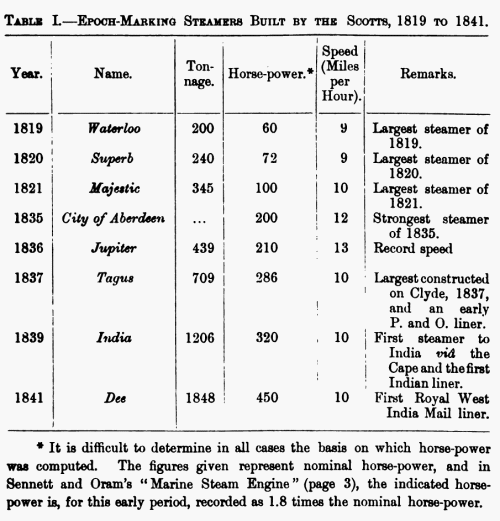
the time "the most compact specimen of its type then in existence," for
although the power developed was 250 horsepower, and the ship was 260 ft.
in length, only 12 ft. 6 in. of the fore-and-aft length was taken up by
the machinery. "Every weight was well balanced, the working parts were
clear and open, and the combined, whole was stable, firm, and well bound
together." The cylinders were 52 in. in diameter, were arranged
diagonally, and worked at right angles to each other, with a stroke of 3
ft. 9 in. The piston-rods projected through the lower covers, to allow of
long return connecting-rods. Each cylinder had two piston-rods, for
greater steadiness, their outer ends in each case being keyed into a
crosshead, fitted at each end with slide - blocks, working in a pair of
inclined open guide- frames, bolted to the bottom cylinder cover, and
supported
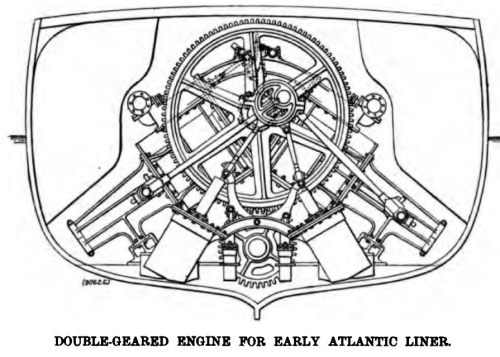
beneath by projecting bracket-pieces, recessed and bolted down upon
pedestal pieces on the engine sole-plate. From each end of this crosshead,
immediately outside the guide- frame, a plain straight connecting-rod of
round section passed up to actuate the main first-motion shaft. The upper
ends of the connecting-rods were jointed to side- studs, or crank-pins,
fixed in two opposite arms of a pair of large spur-wheels, which gave
motion to the screw-shaft by means of a pair of corresponding
spur-pinions, fixed on the shaft.
The main spur-wheels were 11 ft. 51 in. in diameter, and the pinions on
the screw-shaft 4 ft. 6 in.; so that the screw propeller made 21
revolutions to each rotation of the engine. The arrangement ensured that
each piston was directly coupled to both of the large wheels, and the
increased length of the crossheads, which the plan involved, was
counterbalanced by the effect of the double piston- rods, for by this
division of the pressure the cross-strain leverage was proportionately
diminished.
The use of steam expansively in multiple - cylinder engines was, however,
the most important factor in the development of the steamship during the
latter half of the nineteenth century.' With low steam pressures and
simple engines the coal consumption, even for moderate- sized ships, was a
serious item in a long sea voyage; and, early in the 'fifties, engineers,
recognising the economy which would result from a successful compounding
of steam, tackled the problems of steam-generation plant to enable the
necessary high initial pressure to be developed with safety. John Elder
had fitted several ships, but was, for a long time, content with an
initial pressure of from 50 lb. to 60 lb. per square inch.
The late John Scott, C.B., was so convinced of the economy of steam at
higher pressures in the compound system that he decided to build, largely
at his own expense, a vessel which would enable him to put the system to a
thorough test. This steamer, constructed of iron in 1858, was the Thetis,
which was, undoubtedly, an epoch-marking ship, as her machinery was
operated at an initial pressure of 115 lb. to the square
inch—exceptionally high for those days.
For the first time, surface condensers were used in association with the
compound marine engine. There were, as shown on Plate XI., facing page 36,
six cylinders, arranged in two groups, each with one high- and two
low-pressure cylinders. The three pistons of each group worked one
crosshead, connecting-rod, and crank. Each group had two slide-valves, one
for the high-pressure and one for the low-pressure cylinders, and both
were attached to one valve spindle and one reversing link. The engines
worked up to 51 revolutions per minute— equal to a piston speed of 255 ft.
per minute—and the maximum indicated horse-power was 256. The engines were
tried by the late Professor Macquorn Rankine, F.R.S., who certified that
the coal consumption on trial was 1.018 lb. per indicated horse-power per
hour: an extraordinary result, even in the light of modern improvements!
A large part of this efficiency was due to the boilers, which were of the
Rowan water-tube type, and are illustrated on the opposite page. They had
square vertical water-tubes, and through each of these there passed four
hot-gas tubes. They evaporated 11 lb. of water per pound of coal, which
was 30 per cent. higher than was attained with the best marine boilers of
those days. The coal consumption at sea was about 1.86 lb. per indicated
horsepower per hour.
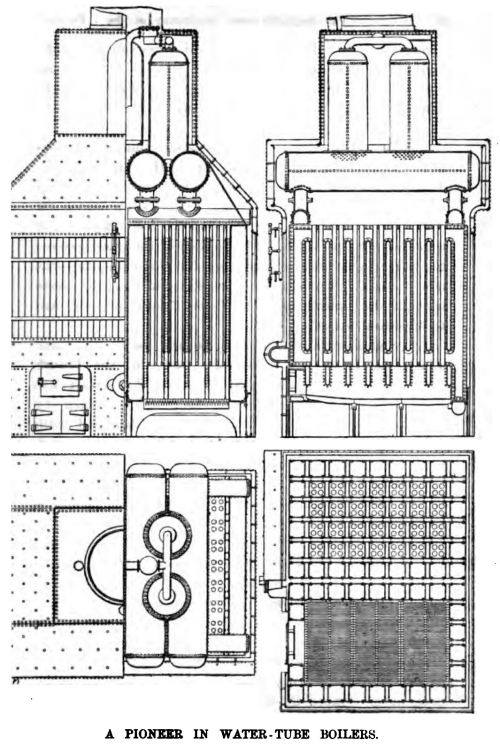
Unfortunately, there soon developed small holes in the boiler-tubes, owing
to erosion of the external surface, probably the consequence of the
chemical action set up by the steam for cleaning the tubes mixing with the
soot and other deposit." Although for this reason this early water-tube
boiler did not succeed, there is no doubt that the performances suggested
improvements which have since brought complete success to this system of
boiler. At the same time, the efficiency of high steam pressures was
completely established and resulted in very considerable progress in the
size and power of steamships.
Another innovation which suggested future developments was the fitting at
the base of the funnel in the Thetis of a series of water-tubes for the
purpose of utilising the waste heat from the boilers to evaporate water
for subsequent condensation to make up the boiler feed. The time was not
ripe for such a utilisation of the waste gases— the heat was insufficient
to generate the required steam—but now various schemes are applied for
absorbing the waste heat in the uptake to heat air for furnace draught and
to superheat steam.
A number of water - tube boilers were made, and a set was fitted into a
corvette built for the French Navy. This vessel, completed in the early
'sixties, was the first ship in the French fleet to be driven by compound
engines, and will fall to be described with other vessels in our next
Chapter, dealing with the work of a century for the Navy.
Perhaps the most significant indication of the success of the Scott
compound engine is found in the results of its application to the early
bit steamers. Alfred Holt commenced trading with the West Indies in 1855,
while his brother, George bolt, became associated with Laniport in the
River Plate trade in 1865. Both lines continue among the most successful
in British shipping.
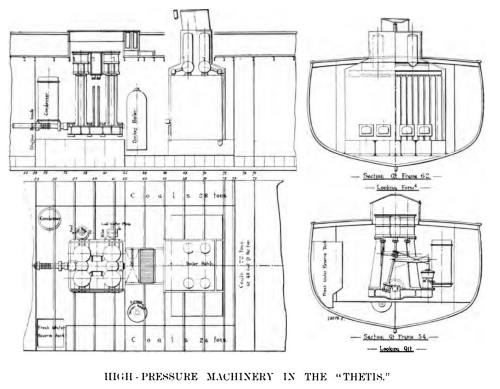
The Holt steam line to China was commenced in 1865, and was the only one
vi2 the Cape of Good Hope which proved at once successful. Built and
engined by the Scotts, the early bolt liners, starting from Liverpool,
never stopped till they reached Mauritius, a distance of 8500 miles, being
under steam the whole way, a feat until then considered impossible.'
Thence the vessels proceeded to Penang, Singapore, Hong Kong, and
Shanghai. Unaided by any Government grants, they performed this long
voyage with great regularity.
The three vessels which inaugurated the very successful Holt line were
named Agamemnon, Ajax, and Achilles, and were built of iron by the Scotts
in 1865-6. They were each 309 ft. in length between perpendiculars, 38 ft.
6 in. beam, and 29 ft. 8 in. in depth, with a gross tonnage of 2347
tons—dimensions which were then deemed too great for the China trade, but
which experience soon proved to be most satisfactory. Sails were fitted to
the vessels, as shown in the engraving on the Plate facing page 40.
Alfred bit was the first to apply the compound engine to long voyages, and
his vessels were the earliest of the type built for the merchant service
by the Scotts. It is true the Pacific Company had compound engines fitted
to one or two ships prior to this, but these were only used in the
coasting trade. The engines of these bolt liners are therefore of
historical interest, and general drawings are reproduced on the next page
and on Plate XII. A feature in these liners was that the propeller was
abaft the rudder, which worked in an aperture in the deadwood
corresponding to that for the propeller in single-screw modern ships.
A detailed description from the specification of the machinery may be
reproduced, as it indicates the practice of the Scotts for a considerable
time. Indeed, this type of compound engine, with slight modifications, was
the standard engine for bolt liners until the advent of the
triple-expansion engine. The details follow:-
The cylinders were: high-pressure, 30 in. in diameter; low-pressure, 62
in. in diameter, with 4 ft. 4 in. stroke, arranged vertically in tandem
fashion, with the low-pressure cylinder on the top. There were two
connecting-rods, but a common crosshead for the tandem cylinders, and a
common crankpin.
The crankshaft was 131 in. in diameter, with a bearing 30 in. long at the
aft end of the bedplate, which took the propeller thrust. The propeller
was three-bladed, 17 ft. in diameter, with 26 ft. 6 in. pitch; with 46
revolutions per minute the piston speed was 400 ft. per minute. To ensure
smooth working with the single crank, a heavy flywheel was fitted, and the
pump levers carried a massive weight to help to balance the weight of
pistons and rods.
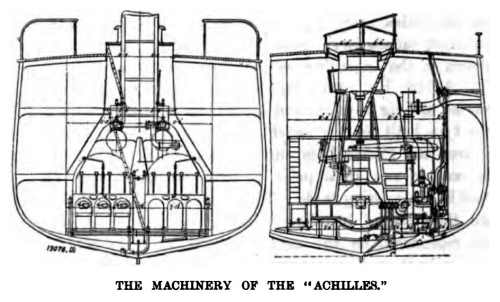
The condenser had 420 tubes 4 in. in diameter, giving a cooling surface of
1375 square feet. The tubes were arranged in three nests, the water
circulating through the top one first and the bottom one last. The
circulating pump, instead of forcing water through the tubes, as was usual
in such case, sucked from the condenser and discharged directly overboard.
There were: one air pump, 24 in. in diameter; one circulating pump, 24 in.
in diameter; two feed pumps, 41 in. in diameter; and one bilge pump 7 in.
in diameter: all the pumps were single-acting, with 17 in. stroke. The
diameters of the principal pipes were: main steam, 7j in.; to low-pressure
cylinder, 12 in.; circulating inlet, 10 ins; discharge, 12 in.; air-pump
discharge, 10 in.; main feed, 3j in.; and waste steam, two at 6 in.
diameter.
The two boilers were double-ended, of the locomotive type, with wet-
bottomed furnaces. The centre was cylindrical, but the ends were
rectangular with semi-cylindrical tops, the total weight, without water,
being 78 tons. Each boiler had a long receiver passing through the uptake
to dry the steam. On the receiver was a deadweight safety-valve Bk in. in
diameter, to suit a working pressure of 60 lb. per square inch. The grate
surface was 112 square feet, and the total heating surface 4506 square
feet, there being 328 iron tubes d4 in. in diameter.
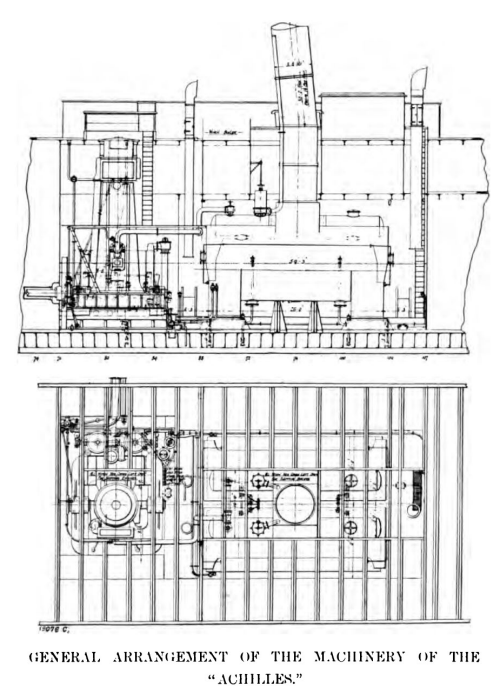
The three pioneer ships of the Holt line - the Agamemnon, Ajax, and
Achilles—proved most economical. The Achilles came home from China in
fifty-seven days eighteen hours, net steaming time, or, including the
stoppages at ports, sixty-one days three hours. She travelled during this
period a distance of 12,352 miles, on a consumption of coal which did not
exceed 20 tons per day for all purposes,' equal to 2+ lb. per unit of
power per hour, which for those early days, with comparatively low steam
pressures, must be regarded as a highly satisfactory result.
The non-stop voyage between Liverpool and Mauritius was made as early as
1866 in thirty-seven days, equal to 10 knots, with a number of passengers
and a fair cargo. The higher economy established for the compound engine
on long voyages resulted in the ultimate supersession of the sailing
ship.2 Thus the Scotts, while still enjoying the credit of the splendid
performance of the Lord of the Isles in the early 'sixties, produced at
their foundry the bit compound engine, which sounded the death-knell of
the clipper. The compound system had at once an influence on the size of
ships. Up till 1862 no ship of over 4000 tons had been constructed, with
the exception of the Great Eastern; by 1870 there were fifteen; by 1880,
thirty- seven.
The Scotts, aided by bolt, continued their research towards higher
economy, and a large fleet of steamers was built, with engines having
flywheels which, it was found by experience, considerably improved the
economy up to a certain stage, although with increased pressure the
proportion of saving was not commensurate with the weight of the wheel,
and the three-cylinder three-crank engine was ultimately adopted.
The Scotts throughout the century continued to have a close association
with the China trade, constructing a long series of successful steamers
for the Holt company and for other lines, with services from Britain to
the Far East, and carried out very extensive work in the building up of
the coasting trade of Asia and Oceana. For the Holt line alone there have
been constructed by the Scotts forty- eight steamers, aggregating 148,353
tons; while the propelling machinery of these represents 19,500 nominal
horse-power. For the India and China services there have, in the past
fifty years, been completed over one hundred and thirty steamers.
The China Navigation Company, Limited, was formed in 1873 by Messrs. John
Swire and Sons, of London, for trading in China, and the first steamers
built for them by the Scotts were two vessels of 1200 tons gross,
completed in 1876.

Since then the Scotts' yard has practically never been without a vessel
for one or other branch of the Eastern trade, and particularly for the
China Navigation Company, which runs steamers from China as far south as
Australia, as far west as the Straits, and as far north as Viadivostook
and the Amur river. They also have ships trading up the Yangtsze Kiang to
Ichang, 1000 miles from the sea, where the rapids prevent navigation
farther into the interior. For this service the twin-screw steamer was
adopted in 1878, much earlier than in many other trades, largely owing to
the strong advocacy of the late John Scott, C.B. Up to that time most of
the Yangtsze steamers were propelled by paddle-wheels driven by
walking-beam engines. The first of the twin-screw steamers was built in
1878—a vessel of 3051 tons gross—and there has been constructed since then
a long succession of very serviceable steamers. For this line alone,
sixty-four vessels have been constructed by the Scotts, the aggregate
tonnage being 115,600 tons, while the nominal horse-power of the
propelling machinery fitted to these vessels is 15,000 horse-power.
But having in our brief historical sketch come to times within the
recollection of the reader, it may be more satisfactory to depart from the
purely chronological review of the company's operations, and to offer
rather an analysis of the progress made, deferring a description of
typical modern steamers for a separate Chapter.
The direct-acting vertical engine, with inverted cylinders, almost as we
know it to-day, and as illustrated in connection with the work of the
twentieth century, was introduced in the late 'fifties. The compound
engine, introduced in 1854, was developed into the triple-expansion system
in 1882, and later into the quadruple-expansion type; but this latter has
not been much adopted, only some 3 per cent. of the vessels registered at
Lloyds being so fitted. This is in a large measure due to the satisfactory
economy attained with triple-expansion engines. As to the progress made,
Table II., giving average results at different periods, is instructive.
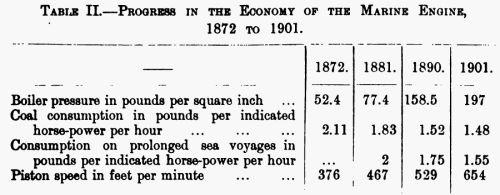
The advance of the century may be popularly expressed by stating that,
whereas in the first coasting steamships built by the Scotts the fuel
consumed in carrying 1 ton of cargo for 100 miles was 224 lb., the
expenditure to-day is from 4 lb. to 5 lb. The economy of the steam engine
has accounted, as is shown in the Table, for a considerable part of this
improvement. But, at the same time, the growth in the size of ships has
enabled the normal speed of 10 knots to be realised, with an addition to
engine power of - much less ratio than the increase in the capacity of the
steamer. As to speed, recent progress has been most marked in the Navy,
and it is therefore fitting that here we should direct our attention to
Naval work.
|

